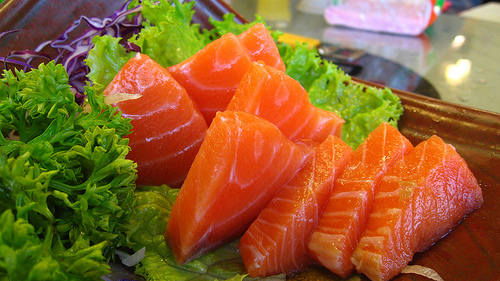当前位置: Language Tips> 双语新闻
Sushi's secret: Why we get hooked on raw fish

|
Raw fish is sizzling hot right now. Los Angeles has brand new bars devoted to an Italian style of raw fish, called crudo. President Obama kicked off his visit to Asia last month noshing nigiri at Jiro's famous sushi bar. And back in December, The New York Times named Sushi Nakawaza as its top restaurant of the year. But why do so many of us find utter bliss in eating raw sea creatures but aren't so inclined to chow down on uncooked birds, cows or pigs? A big part of it is gravity — or the effective lack of it in the ocean, says biophysicist Ole Mouritsen, author of Sushi: Food for the Eye, the Body and the Soul. "Fish are so soft. You can stick your finger through their muscles," he says. "Try doing that with a chicken or cow. Fish muscle is very different than that in land animals." Why? Because fish can afford to be lazier than terrestrial animals. Fish essentially float all the time. So their muscles don't work constantly to fight gravity. "Fish don't have to support their body weight," Mouritsen says, "so their muscle fibers are shorter and less tough than those in land animals." The same goes for the connective tissue holding the muscle fibers together: It's delicate and weak. The result? Fish has a silky, smooth texture when it's raw, and a flaky, light texture when it's cooked. By contrast, "Land animals — like ourselves — are always working to keep themselves upright and keep their shape," Mouritsen says, so our muscle fibers are thicker, tougher and firmer. The result is a ropy, chewy — and less appetizing — texture when the meat is raw. Cooking softens the connective tissue in meat and improves its texture (it also makes it juicy and flavorful). In general, the more a muscle works, the tougher, more iNews,双语新闻,双语,it gets, Mouritsen writes in his book. This idea explains why the belly of the tuna, known as otoro, is exceptionally soft: The belly of the fish is the laziest muscle of them all. "In contrast, those muscles that are more active in a tuna, say the ones in its fins and tails, are a bit more chewier than other muscles," he says. Under a microscope, fish, chicken and other meat muscles look similar, with long, parallel fibers, like ropes, stretched out and tied together. But when you zoom in a little closer, the fish muscles look like the Kate Moss of the bunch: Their fibers are slimmer, shorter and more delicate than the others. The muscle properties of fish also explain the rainbow of colors you see at a sushi bar. "Fish that are constantly on the move — say, a tuna — have muscles that are always working and burning carbohydrates aerobically," Mouritsen says. The muscles need oxygen to make energy. And the molecule that carries oxygen to muscle contains iron. Guess what color iron is in the fish? Red. In contrast, fish that mostly hang out in one place or on the bottom of the ocean — say, for instance, flounder — have muscles that don't rely on oxygen to create energy. No oxygen means no iron to carry it, which means the muscles tend to be white. (Of course, most fish have a mixture of these two type of muscles and thus can look red, white or pink.) So what about the pinkish-orange color of salmon? That's a special case, Mouritsen says. "The coloring is due to what salmon eat: shellfish that are enriched with a pigment that's related to carotene in carrots, called astaxanthin." This pigment creates the characteristic bluish-gray or green color of raw shrimp and crabs. The molecule turns bright pink or orange when the salmon eats the shellfish or we cook it. |
生鱼片现在可是炙手可热。 洛杉矶新开了许多餐馆,专卖一种叫做克鲁多(Crudo)的意式生鱼片。奥巴马总统上个月出访亚洲期间,也抽空去了著名的数寄屋桥次郎寿司店品尝生鱼片寿司。而在去年十二月,Nakawaza寿司店被《纽约时报》评为年度最佳餐馆。 但为什么我们一方面对生鲜海产品趋之若鹜,一方面又觉得生禽肉、生牛肉或生猪肉难以下咽呢? 生物物理学家奥利·莫里特森(Ole Mouritsen)说,一个很重要的原因就是重力——或者说重力在海里的作用微乎其微。他写过一本书,叫做《寿司:养眼、果腹又提神的食物》。 “鱼类相当柔软,你可以用手指直穿它们的肌肉,”他说:“你再拿块鸡肉或者牛肉试试,肯定不行。鱼类的肌肉和陆地动物的肌肉有很大不同。” 为什么呢?因为鱼类的生活比陆地动物“更慵懒”。鱼类一直都浮在水中,所以它们的肌肉不用长期对抗重力作用。 莫里特森说:“鱼类不用承受自身体重,所以它们的肌肉纤维比起陆地动物更加纤细,也没那么强健有力。”用于连接肌肉的结缔组织同样柔软无力。 这样的特点导致了什么结果?生鱼肉如丝般顺滑,而熟鱼肉轻盈剔透。 莫里特森说,相比之下,“陆地动物——比如我们人类——需要一直保持站立的姿态。”所以我们的肌肉纤维更密集、更强健、更结实。 因此,陆地动物的肉在没煮熟的情况下韧性大、难咀嚼——而且味道也不好。烹饪可以软化肉中的结缔组织,并且改善肉质(还可以使肉变得多汁有味)。 莫里特森在其书中写道,总体来讲,肌肉越用越强健,越用越弯曲。这就解释了为什么金枪鱼的肚子——也就是鱼腩——超乎寻常的柔软。金枪鱼肚子上的肌肉是全身活动量最少的肌肉。 他说:“相比之下,金枪鱼身上更常用的肌肉,比如鱼鳍和鱼尾上的肌肉,就比其他部位的肌肉更有嚼劲。” 在显微镜下观察的话,你会发现鱼类、禽类和其他肉类的肌肉看起来差不多,都有长长的平行纤维,像绳子一样紧紧绕在一起。 但如果再放大看的话,鱼类的肌肉看起来就像肌肉界的凯特·摩斯(英国超级模特):比其他肌肉更纤细、更短小、更柔弱。 鱼类肌肉的这些特性也解释了为何寿司里的鱼肉看起来五颜六色。 莫里特森说:“一直游动的鱼——比如说金枪鱼——它的部分肌肉一直在活动,通过有氧运动消耗碳水化合物。” 肌肉需要氧气来制造能量,而负责输送氧气到肌肉里的小分子载体含有铁元素。猜猜铁元素在鱼肉里呈什么颜色?红色。 相对而言,像比目鱼这种不四处游动或只呆在海底的鱼,它们的部分肌肉不需要氧气来制造能量。没有氧气也就意味着没有铁元素,也就是说这些肌肉呈白色。(当然,大多数鱼类具有两种肌肉,因此有的肌肉呈红色,有的呈白色或粉红色。) 那鲑鱼肉的颜色为什么又粉又橙呢?莫里特森说,这是特例。 “鲑鱼肉的颜色取决于鲑鱼吃什么:鲑鱼吃的甲壳类动物富含一种叫做虾青素的色素,这种色素和胡萝卜里的胡萝卜素有一定联系。” 虾青素让生虾肉或生蟹肉呈蓝灰色或绿色。当贝壳类动物被鲑鱼吃掉或经过我们烹饪后,其体内的小分子就会变为亮粉色或橙色。 (译者 Leedish 编辑 丹妮) 扫一扫,关注微博微信
  |
上一篇 : 2014年最有纪念意义的毕业典礼演讲名言
下一篇 : 2014世界杯专题:世界人民看FIFA
电话:8610-84883645
传真:8610-84883500
Email: languagetips@chinadaily.com.cn